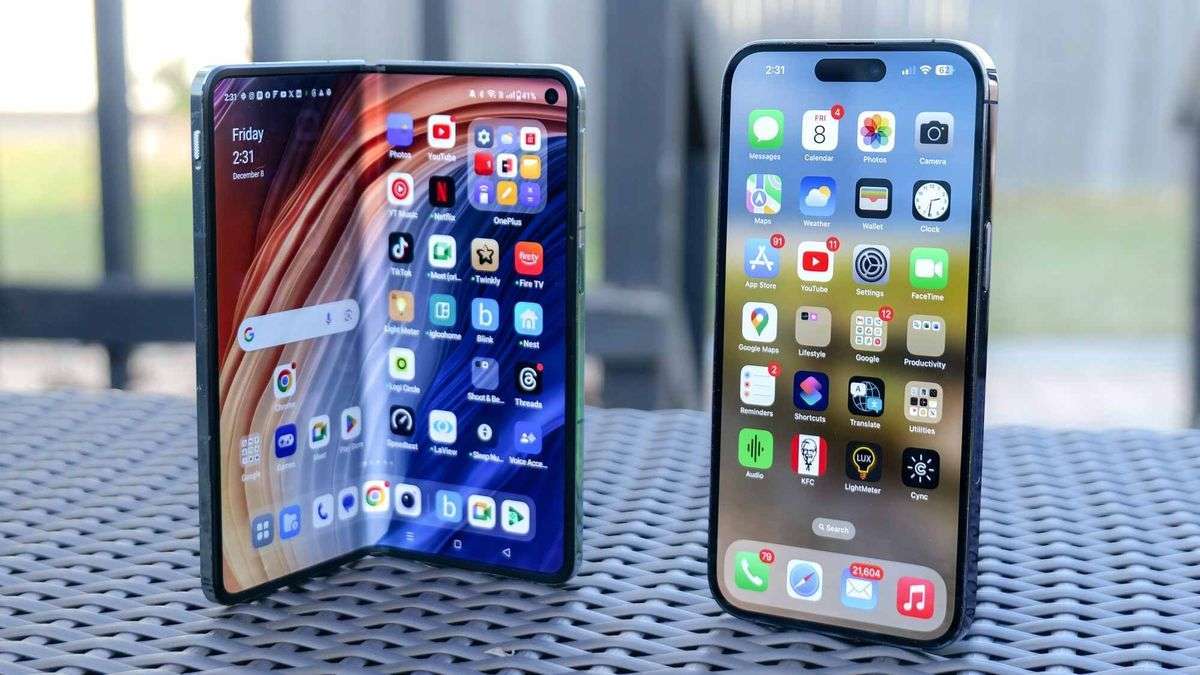I recently decided on a whim to ditch my trusty iPhone 15 Pro and try out the buzzy new OnePlus Open foldable phone. As a smartphone reviewer keenly tracking industry trends, I was intrigued to experience firsthand the most exciting new form factor in years – a book-style folding display marrying smartphone portability with small tablet real estate.
After spending a couple of weeks putting the Open through its paces as my daily driver, I came away impressed by OnePlus’ polished attempt at a maiden foldable. The svelte hardware design belies the phone’s foldable origins, while the capable Hasselblad-tuned cameras deliver photography on par with far costlier flagships.
However, trading my iPhone did cast into stark relief some niggling drawbacks in the wider Android and foldable space that give me pause. The lack of wireless charging on the Open is a hugely inconvenient omission for a $1,799 device. Moreover, Apple’s vice-like grip on the premium smartphone market perks like best-in-class processors, unrivaled accessory ecosystems and multi-year software support remains unmatched.
Overall though, my fling with the Open left me a foldable convert. The generously enlarged screen real estate transformed my workflow, blazing through tasks impossible on conventional form factors. As the technology matures, components shrink and prices soften, foldables seem poised to devour the mainstream smartphone world.
Here are 5 key reflections from my experience making the leap to using the OnePlus Open foldable as a daily driver:
- Android Desperately Needs A Seamless MagSafe-Like Wireless Charging Ecosystem
One of my biggest gripes upon switching to the Open was the shocking lack of wireless charging. As an Apple power user, I heavily relied on the seamless convenience of MagSafe – effortlessly charging my iPhone 12 Pro using desktop stands, bedside docks and battery packs on the go.
Regressing to plugging in USB-C cables like a caveman felt egregiously outdated. OnePlus ditching wireless charging altogether on their $1,799 flagship-grade foldable is utterly inexplicable. And it highlights the wider superiority of Apple’s tightly integrated MagSafe feature for fuss-free magnetic wireless charging and accessories across all iPhone models.
Android OEMs desperately need to step up and widely support the Qi2 standard that mimics MagSafe functionality. Smoother wireless charging can no longer remain an iPhone-exclusive party trick. Premium foldables like the Open must ensure parity on table-stakes flagship phone perks to compete in their lofty price segment.
- The Sea-Sized Inner Screen Upended My On-The-Go Productivity
The OnePlus Open’s expansive 7.8” inner folding screen blew me away with what you can achieve on an ostensibly phone-shaped device. App interfaces scale up beautifully on the enlarged, immersive display with its slender bezels.
Webpages, spreadsheets, Shot-on-iPhone film edits, Kindle novels – everything became easier to manage with the real estate upgrade. The text density increase alone makes much lighter work of plowing through my inbox backlog and monitoring analytics dashboards.
The Open Canvas multitasking allowed seamless split-screen work, flipping between apps with abandon. While Android endures its share of bugginess, the foldable form factor offers a glimpse of the productivity possibilities as Google fine-tunes the experience.
- My Kindle Has Been Permanently Retired
Another unexpected benefit of having a small tablet grafted to your phone is neutering the need to carry a separate e-reader. The Kindle app perfectly tailors itself to the Open’s dimensions, enable sublime comic book reading and novel plowing in bed while saving on device redundancy.
Combined with a generous 512GB of onboard storage, you can easily load up the Open with entire digital libraries worth of reading material without repeating titles for weeks. That’s one less item to worry about charging on trips or leaving behind at home.
- Stability vs Features? Apple Still Reigns Supreme
While wowed by the Open’s productivity revelations, using the foldable reinforced Android’s enduring shortcomings relative to iOS. Apple’s walled garden approach favors reliability and stability over features. In contrast, I encountered more instability like frozen apps and system hiccups on the Open during my testing.
OnePlus promises 4 years of Android OS updates for the Open. However, Apple iPhones are supported for up to 6 years with updates – you can still upgrade an iPhone 8 to iOS 16! Risk-averse buyers who favor assurance over cutting-edge spec sheets will opt for iOS’s tranquility. Of course, Android offers significantly richer customization freedom for power users happier trading some stability.
- Foldables Are Still Wildly Exciting and Will Only Get Better
Spending time with the remarkably polished OnePlus Open foldable revived my sense of possibilities with smartphone form factor innovation. Folding displays meaningfully boost both work and play scenarios without the bulky compromises of small tablet carry.
As reliability steps up and costs decline, I foresee foldables aggressively eating into – and perhaps eventually usurping – the slab flagship candybar market. The Open is evidence ambitious first-gen products can still be remarkably refined. Another generation of refinement solving durability, efficiency and stability gripes could make Android foldables irresistible tech lust objects.
If Samsung meets its stated goal of foldables capturing 50% of its global high-end shipment volumes by 2025, the writing is clearly on the wall. Huawei, Oppo, Xiaomi and others are all gunning to challenge Samsung’s foldable supremacy as well. A crowded field spells good news for consumer choice.
Conclusion
My fling with the OnePlus Open left me thoroughly sold on foldable phones as transformative new category poised to dominate the premium landscape. Usability is already excellent in 2023, and rapid improvements in pricing, specifications and software maturity feel inevitable as juggernauts like Samsung, Google and Apple double down.
Within 2-3 years, settling for a slab flagship form factor risks feeling boring when affordable foldables offer powerful productivity in a pocket-friendly package.
OnePlus has made an assured debut brimming with promise. It suggests ambitious Chinese OEMs will aggressively jostle Samsung for foldable leadership positions. With Apple reportedly prepping a foldable iPhone and Google sharpening Android 13 for large screens, the stage is set for foldables to blitz the high-end phone market.
Early adopters will bear the brunt of teething problems like flaky app scaling behavior and durability questions. However, mainstream buyers on 2-3 year upgrade cycles may be wise holding out a generation to let the foldable wave mature. By 2025, we could be facing a dramatically transformed mobile device landscape. The capable OnePlus Open offers a tantalizing early glimpse at the folding future that awaits most consumers sooner rather than later.























